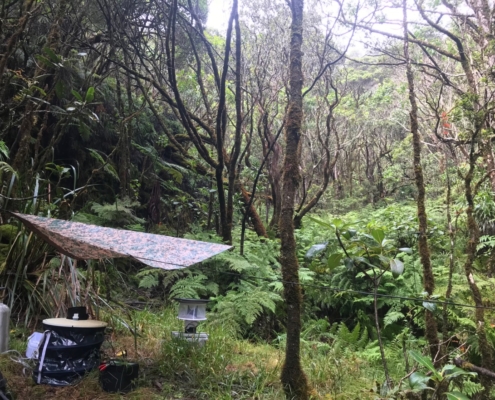MOSQUITO MONITORING
By Teya Penniman, Coordinator of Hawaii Landscape-scale Mosquito Control at American Bird Conservancy
The Why:
We face an extinction crisis. Climate change and globalization are driving the ecosystems and species that we protect – our biological heritage – to extinction. In the United States Pacific Island ecoregion alone, more than 580 species, over one-third of the listed species in the U.S., are currently in danger of extinction. Many more of these endemic species are on the same trajectory. Our best projections predict that these declines will continue unabated and with increasingly severe consequences, unless we take action now.
The reasons behind the decline of Hawaiʻi’s endangered native forest bird populations are emblematic of this extinction crisis. These iconic species face threats not present during their evolution on these islands, leaving them poorly adapted for their recently invaded ecosystems. To conserve our biological heritage for future generations, introduced diseases (such as avian malaria transmitted by the Southern house mosquito) and mammalian predators (rats, cats, and mongoose), must be controlled to maintain healthy ecosystems. For some of our native forest bird species, avian malaria causes more than 90 percent mortality.
The What:
Higher-elevation forests in Hawaiʻi do not have the Southern house mosquito. These remote upper-elevation montane forest refugia, which now protect Hawaiʻi’s forest birds from the devastating effects of avian malaria, are projected to drastically decline in size in the very near future. Due to a warming climate these heat-loving mosquitoes will be able to spread upslope.
One promising tool to help stop this decline is the “Incompatible Insect Technique,” which uses a naturally-occurring bacteria called Wolbachia (see video below) to interrupt mosquito reproduction, thereby reducing mosquito populations. This strategy acts like an insect birth control and is not a genetic modification. Instead, it depends on releasing into the environment male mosquitoes (which don’t bite) that have been exposed to the Wolbachia bacteria. When these males mate with females in the wild, no viable offspring are produced. Fewer mosquitoes means fewer vectors of avian malaria. This approach is currently in use on the U.S. mainland and elsewhere in the world to help suppress mosquitoes that carry human diseases, such as dengue or Zika. It is considered so safe that in some areas, residents have regular packages of male Wolbachia shipped to their home during the mosquito “season.”
The Steering Committee for Landscape Scale Mosquito Control, a partnership of federal, state, academic, and nonprofit agencies, is working with Michigan State University (MSU) to lab-rear male southern house mosquitoes that have been infected with the Wolbachia bacteria. The work at MSU is still in its infancy. Rearing protocols for the Hawaii-collected Southern house mosquito are still being developed and tested in Hawaiʻi and at MSU. Once these protocols are developed and a viable population can be reliably mass-reared in the laboratory, work on infecting the lab-reared populations with Wolbachia strains found in Hawaii will be conducted.
The Incompatible Insect Technique has been shown to be both safe and effective, but its conservation application in Hawaiʻi will be novel. Any releases into the environment will require community engagement, public input, and permits from federal and state regulatory agencies. It is a challenging strategy, but one of the only ones we have left, especially given recent results of a forest bird translocation project on Maui indicating that mosquitoes have advanced further upslope than previous surveys indicated. Supplementing the protection that our natural areas provide to these birds in terms of habitat with a landscape-scale mosquito control program will enhance the capacity of these refugia to support future populations of endangered forest birds in Hawaiʻi.
Monitoring in the Alakaʻi
To increase the potential of this work on Kauaʻi, KFBRP and USGS field technicians and some very dedicated volunteers have worked tirelessly to capture the Southern House Mosquito (or Culex quinquefasciatus) within native forest bird habitat. The main focus was our highest elevation field site, where we spent 10 months trapping mosquitos from fall 2018 til late summer 2019. We also visited six other sites at varying elevations from March-July to learn more about the distribution, seasonality, and survivorship of these mosquitos that are right on the edge of penetrating pristine forest bird habitat. Trips in winter and spring months yielded low mosquito numbers, while as many as 48 adult southern house mosquitos were captured over just seven trap nights in August of this year at our high elevation site. If we were able to keep the mosquitos alive long enough (using cotton balls soaked in sugar water) to survive the helicopter ride out of the field, we then quickly shipped them to US Fish and Wildlife Service in Honolulu, where they were reared up. These individuals will be the founders of the IIT populations that will one day be rereleased on Kauaʻi to control the mosquito population and save the birds.
For more information about mosquitos in Hawaii, check out our Mosquito FAQ



